Cf-252 fission neutron source and NE-213 scintillator inside a concrete room
In this MCNP simulation, a user defined Cf-252 neutron source, characterized by emission from a fission fragment in a given direction, and a NE-213 liquid scintillator are inside a concrete room. The Cf-252 source is finite in size; a small cylinder, 10 mm in diameter and 5 mm deep. The NE-213 liquid scintillator is also contained in a cylinder (5 cm diameter, 5 cm deep), whose axis coincides with the Cf-252 source's axis. The center of the sources is exactly 25 cm from the front face of the scintillator. The axes of both the source and the scintillator are at a height of 1 m above the concrete floor. The problem is 10 x 10 x 10 m3 in size and the concrete room consists of a 10 x 10 m2 floor and 5 m tall walls. All concrete structures are 30 cm in thickness. The geometry of the problem is identical to Cf-252 Watt neutron source and NE-213 scintillator inside a concrete room.
The user-defined source subroutine (source-cf252.F90) needs to be recompiled into MCNP. The subroutine samples two fission fragment mass number and kinetic energy, one heavy and one light fragment, using a random Gaussian distribution. The mean and width of the Gaussian distributions are given by experimental values of Cf-252. The direction of the fission fragment is sampled isotropically in a cone of given angle and apperture. The aperture defines a fission detector solid angle (not included in the geometry). Next, three possible neutron sources are considered; emission from the light fragment, from the heavy fragment, or near-scission emission. The probability of each occurrence is sampled using experimental values. The neutron kinetic energy is sampled with a Maxwell-Boltzmann distribution in the rest-frame of its source, using experimental values for the nuclear temperature. Its velocity is transformed to the laboratory system, if emission originates from either fission fragment. The subroutine also samples x, y, z positions inside the source container and returns the position, direction, the energy, time and the particle type (neutron). The angle and aperture of the fission fragment emission cone can be modified within the MCNP input file.
This simulation does not have tallies. Instead, events entering the front-face of the NE-213 liquid scintillator are saved to file (PTRAC). The optional software ptrac2root can be used to convert PTRAC events to a ROOT TTree data structure.
The input file (cf252) of this MCNP simulation is well documented with comments, and is meant to be modified or augmented with other structures if desired.
Demo
The following picture shows the simulation geometry (from the MCNP plotting utility),
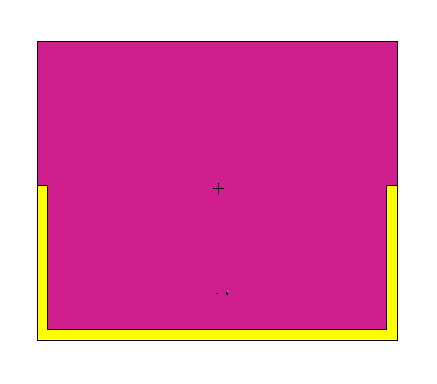
The cyan color represents air, and the yellow the concrete floor and walls. Barely visible, above the floor, is the source and scintillator. The following fade-in picture shows the geometry of the Cf-252 source (green) and Ne-213 liquid scintillator (blue), viewed from the side,
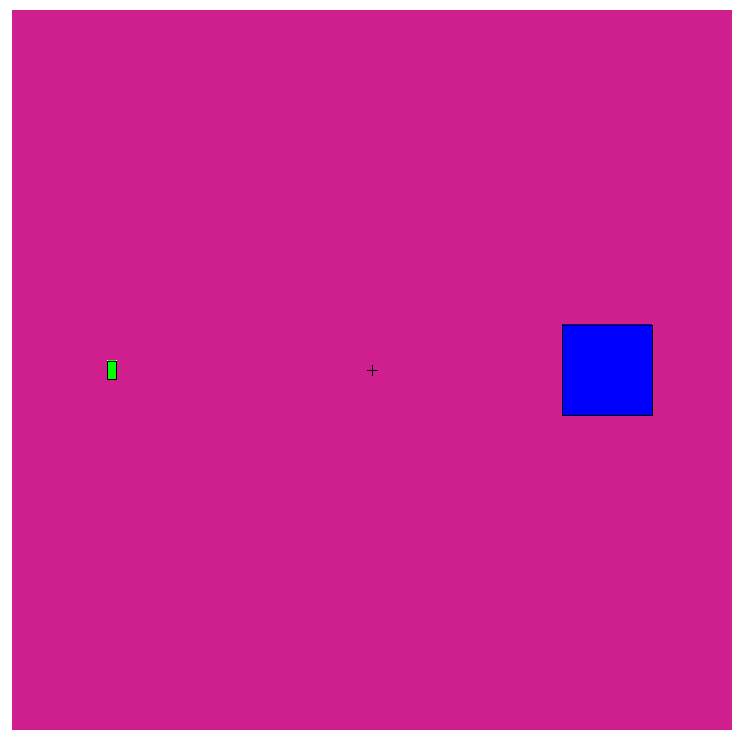
Not clearly seen, the structures are two cylinders facing each other.
Running MCNP with 100 million events, at fission fragment angles 90°, 60°, 30° and 0°, with 1.5° aperture, yield the following spectra of neutrons entering the face of the scintillator container,
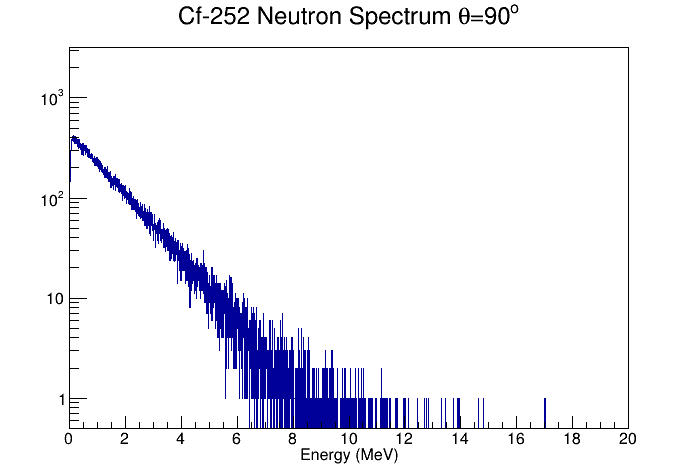
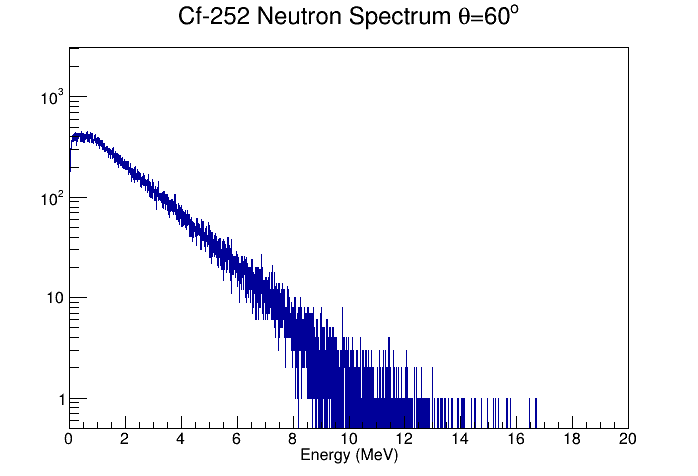
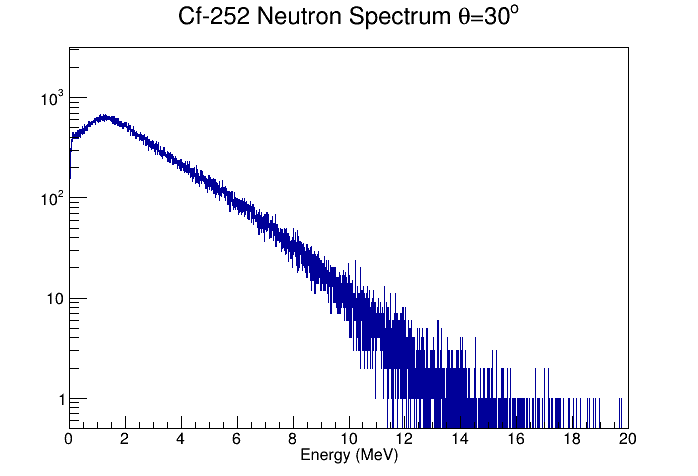
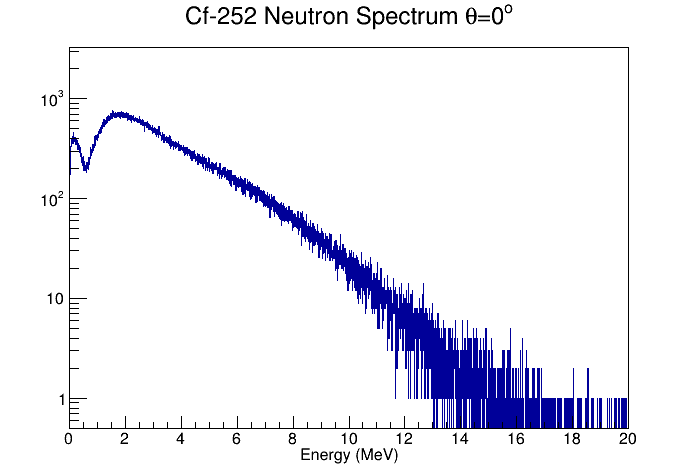
The data has been fitted with the moving source program movsrc, in which five sources are considered; one pre-fission source, two sources moving in the rediretion of the fission fragment detector, one for the light and one for the heavy fragment, and two aditional sources, each moving in the opposite direction to the detector, representing the undetected heavy or light fragments.
Compilation and Execution
This MCNP input has been developed and tested using MCNP version 5. MCNP needs to be recompiled with the new user-defined source, by replacing the dummy source subroutine (source.F90) with the user-defined source subroutine (source-cf252.F90),
$ cd $MCNP_DIR/Source/src
$ cp -a source.F90 source.F90.orig
$ ln -sf source-cf252.F90 source.F90
Recompilation of MCNP depends on many factors; operating system, compiler and MCNP version, to name a few. In general, the complilation is done in the Source/ directory,
and compilation with a command like this,
(sequential execution case). Please consult your MCNP manual.
The geometry of the problem can be viewed with the command,
whereas the simulation itself is executed with the command,
Output
The output of the simulation is a PTRAC file in ASCII format. This file can be converted to a ROOT TTree data structure with ptrac2root. Included is the ROOT file (cf252.root) containing the neutron energy spectrum histograms from the simulation shown above. The histogram is made by ptrac2root. The neutron energy spectrum histogram can be retrieved and displayed by executing the spectrum.C script included,
root [0] .L spectrum.C
root [1] plot()
The script spectrum.C performs a fit with a Watt spectrum function and outputs the parameters and the reduced Chi-squared of the fit.
Dependencies
The MCNP code is export controlled and distributed worldwide through RSICC. Users must register to obtain a copy of MCNP.
Current version of ROOT can be downloaded and installed in most Linux distributions. In Debian-based systems, the tutorial "Installing CERN ROOT on Debian GNU/Linux 12 (bookworm)" may be of use.
Terms of Use and License
Before buying, please read our Terms of Use and License.
List of Files
Included in this software package are the following files:
- cf252 (MCNP input file)
- source-cf252.F90 (MCNP user-defined source subroutine)
- cf252.root (ROOT file with spectrum histograms)
- spectrum.C (ROOT script to display the neutron spectra histograms)
- README (documentation)
- terms.md (terms of use)
- license.md (license)